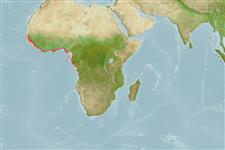>
Perciformes/Serranoidei (Groupers) >
Epinephelidae (Groupers)
Etymology: Cephalopholis: Greek, kephale = head + Greek, pholis = scale (Ref. 45335).
Eponymy: This is a toponym referring to the River Niger; the river (or its mouth, in the case of marine species) being the type locality. (Ref. 128868), visit book page.
More on author: Günther.
Environment: milieu / climate zone / depth range / distribution range
Ecología
marino; salobre demersal; rango de profundidad ? - 100 m (Ref. 26999), usually ? - 50 m (Ref. 57293). Tropical; 30°N - 14°S, 18°W - 13°E (Ref. 5222)
Eastern Atlantic: Senegal to Lobito, Angola, including the Canary Islands (Tenerife).
Tamaño / Peso / Age
Maturity: Lm ? range ? - ? cm
Max length : 30.5 cm TL macho / no sexado; (Ref. 57293); common length : 20.0 cm TL macho / no sexado; (Ref. 26999)
Espinas dorsales (total) : 9; Radios blandos dorsales (total) : 14 - 15; Espinas anales: 3; Radios blandos anales: 8. Diagnosis: depth of body 2.8-3.0 in SL; head length 2.5-2.6 in SL; eye diameter greater than interorbital width, eye diameter 4.6-5.5 in HL; flat interorbital area; rounded preopercle, finely serrate, lower edge fleshy; subopercle and interopercle smooth; convex upper edge of operculum; maxilla scaly, reaching well past eye; lateral-body scales ctenoid, without auxiliary scales (Ref. 89707).
Occurs on mud (Ref. 5222), sand, and rock bottoms (Ref. 5222, 57293) in coastal waters, usually above 50 m depth (Ref. 57293). Exceptionally enters brackish lagoons and estuaries (Ref. 57293).
Life cycle and mating behavior
Madurez | Reproducción | Puesta | Huevos | Fecundidad | Larva
Heemstra, P.C. and J.E. Randall, 1993. FAO Species Catalogue. Vol. 16. Groupers of the world (family Serranidae, subfamily Epinephelinae). An annotated and illustrated catalogue of the grouper, rockcod, hind, coral grouper and lyretail species known to date. Rome: FAO. FAO Fish. Synop. 125(16):382 p. (Ref. 5222)
IUCN Red List Status (Ref. 130435: Version 2024-2)
Threat to humans
Harmless
Human uses
Pesquerías: sin interés
Herramientas
Special reports
Download XML
Fuentes de Internet
Estimates based on models
Preferred temperature (Ref.
123201): 19.2 - 27.9, mean 25.8 °C (based on 80 cells).
Phylogenetic diversity index (Ref.
82804): PD
50 = 0.5000 [Uniqueness, from 0.5 = low to 2.0 = high].
Bayesian length-weight: a=0.01259 (0.00587 - 0.02699), b=3.04 (2.87 - 3.21), in cm total length, based on LWR estimates for this Genus-body shape (Ref.
93245).
Nivel trófico (Ref.
69278): 4.0 ±0.7 se; based on size and trophs of closest relatives
Resiliencia (Ref.
120179): Medio, población duplicada en un tiempo mínimo de 1.4-4.4 años (Preliminary K or Fecundity.).
Fishing Vulnerability (Ref.
59153): Low vulnerability (21 of 100).
